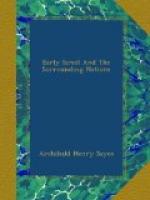The Pharaonic Egyptian resembled in body and character the typical native of Central Egypt to-day. He was long-headed, with a high and intellectual forehead, straight nose, and massive lower jaw. His limbs were well-proportioned and muscular, his feet and hands were small. He belonged to the white race, but his hair and eyes were black, the hair being also straight. His artistic and intellectual faculties were highly developed, he was singularly good-tempered and light-hearted, averse to cruelty, though subject at times to fits of fanatical excitement and ferocity. At once obstinate and industrious, he never failed to carry out what he had once taken in hand. The Nile valley was reclaimed for the use of man, and swamp and jungle, the home of wild beasts and venomous serpents, were turned by his labours into a fruitful paradise.
By the side of the long-headed Egyptian of the ruling classes we find in the age of the earlier dynasties a wholly different type, of which the famous wooden statue now in the Cairo Museum, and commonly known as the “Shekh el-Beled,” may be taken as an illustration. Here the skull is round instead of long, the lips and nostrils are thick and fleshy, the expression good-humoured rather than intellectual. The type is that of a portion of the lower classes, and disappears from the monuments after the fall of the Sixth dynasty. After that epoch the races which inhabited Egypt were more completely fused together, and the rounded skull became rare.
Egyptian history begins with Menes, the founder of the united monarchy, and of the First historical dynasty. Our glimpses of the age that preceded him—the age of the followers of Horus, as the Egyptians termed it—are few and scanty. Egypt was divided into several kingdoms, which were gradually unified into two only, those of the north and the south. The northern kingdom was symbolised by the snake and papyrus, the southern kingdom by the vulture and aloe. The vulture was the emblem of Nekheb, the goddess of the great fortress whose ruins are now called El-Kab; and it is probable that the city of Nekhen, which stood opposite it on the western bank of the Nile, was once the capital of the south. However this may be, when Menes mounted the throne he was hereditary ruler of This, a city which adjoined the sacred burial-place of Osiris at Abydos, and of which Girgeh is the modern successor.
Menes made himself master of the north, and so united all Egypt under one rule. He then undertook and carried through a vast engineering work, one of the greatest the world has ever seen. The Nile was turned aside out of its old channel under the Libyan cliffs into a new channel to the east. The dyke which forced the river from its old course still remains, and two or three thousand years before the bed of the valley had risen to its present level the destruction of the dyke would have meant the return of the Nile to its former path. North of the dyke English engineers have found that the alluvial soil bears witness to interference with the natural course of the river of a far-reaching kind, and its long straight course resembles that of a canal rather than of the naturally winding stream of the Nile.




